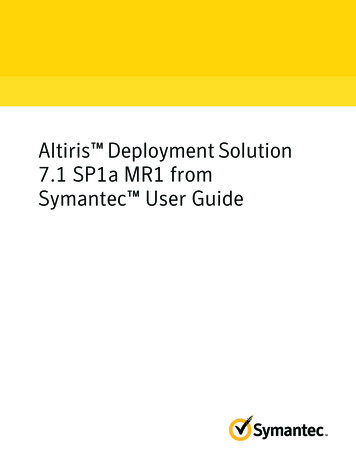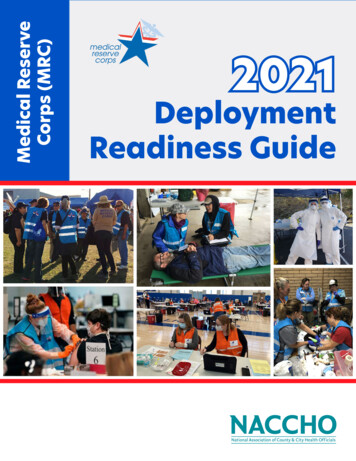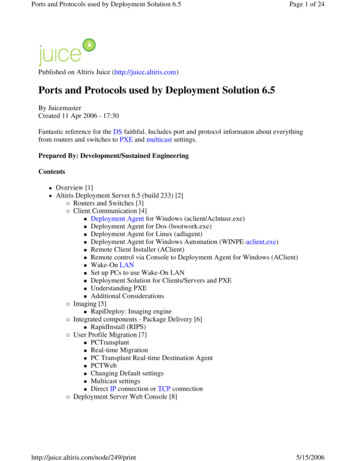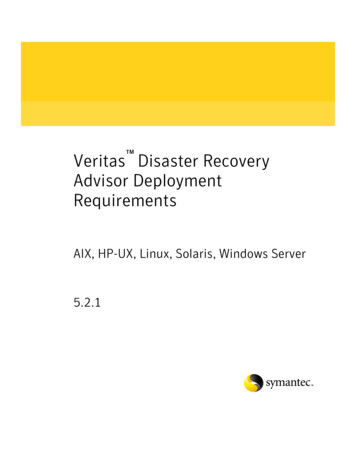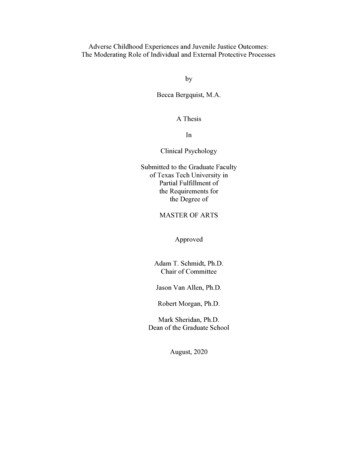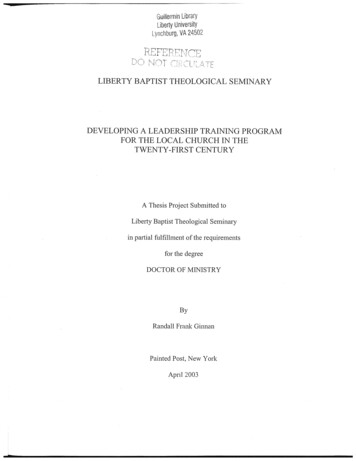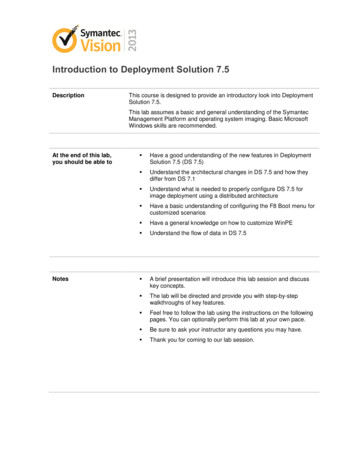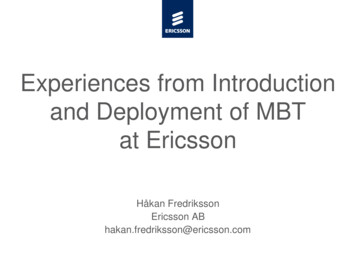
Transcription
Experiences from Introductionand Deployment of MBTat EricssonHåkan FredrikssonEricsson ABhakan.fredriksson@ericsson.com
Contents1.2.3.4.IntroductionModelingTest Case GenerationConclusions Ericsson AB 2011 2011-09-02 Page 2 (33)
MBT - IntroductionInput:Customer requirements,Function Specifications,Function Descriptions,Interface tionModeldesignImportTest CasesInputGenerationAutomatedtest scriptsRenderingPlug-ins(UML) ModelingtoolMBT tool(e.g. Conformiq) ReportHarness/“Library”Test automationtool/frameworkExecuteResults Ericsson AB 2011 2011-09-02 Page 3 (33)
MBT - IntroductionWhere we were before MBT A fairly stable test organization A fairly mature product to test Fairly stable test environment and tools (partly selfdeveloped) Main part (90%) of the Test Cases automated A huge amount of Test Cases/scripts – which had startedto become expensive to maintainThe perfect background for trying out new tools andmethods! Ericsson AB 2011 2011-09-02 Page 4 (33)
MBT - IntroductionWhy we tried it out Striving for Operational Excellence Reduced costs and shortened lead-times, by- generation of test documentation- generation of Test Cases- generation of automated test scripts Increase agility Improve test coverage “Better” ( more complex) Test Cases Improve Test Case and test script quality Inspirational challenge for the testers Highlighting the tester’s role in the organization and so on Ericsson AB 2011 2011-09-02 Page 5 (33)
MBT - IntroductionHow we introduced MBT Conformiq were invited to perform prototyping with analready verified function The prototyping took less than two weeks – and we werereally impressed by the outcome We decided to use MBT and Conformiq for real in a “ live” project A team was put together, and some training withinmodeling and the Conformiq tool took place A suitable new function was selected We just did it Ericsson AB 2011 2011-09-02 Page 6 (33)
MBT - IntroductionConsiderations when deploying MBT Requires stability and maturity- the SUT- the organization- methods used- tools and test framework Select an object/function that is suitable for MBTRecommendation: Use MBT for Functional Testing first,avoid non-functional testing, such as performance test, inthe beginning The substantial gains will be received when:- You have a need for (or benefit of) automated test suites –for example: you run regression tests on a regular basis- All testing can be fully automated – and no manualintervention is needed to test your functionality Ericsson AB 2011 2011-09-02 Page 7 (33)
MBT - ModelingModeling toolsWith Conformiq:- the Conformiq modeler- Rational’s tool kit- IBM/Telelogic RhapsodyConformiq action language: “ QML”/extended JavaOther MBT tools provide other possibilities, for exampleSmartesting, that supports Borland’s Together as well as Rational’s tools, and has OCL as action language. Ericsson AB 2011 2011-09-02 Page 8 (33)
MBT - ModelingRecommendation: Do not use the same model to both generate codeand generate Test Cases!Differ between the two different model types:Development Model Main purpose: generate code Technical model Often contains implementation informationTest Model Main purpose: generate Test Cases Functional model – describing the system behavior of a certainsystem function (or part of a system function) Contains no implementation information Black box model Ericsson AB 2011 2011-09-02 Page 9 (33)
MBT - ModelingWhen designing your MBT model you can have two differentapproaches: Design your model from scratch – independently fromother existing models Reuse and adapt other existing development models:- Customize the model to your needs- Simplify the model- Strip all irrelevant information from the model- Make sure that it is black box, and describes thesystem behavior in a proper way Ericsson AB 2011 2011-09-02 Page 10 (33)
MBT - ModelingOne possible approach:High level system modelTest ModelStripped modelModeladaptationsBlack boxResponsible:Test departmentBlack boxResponsible:System departmentDevelopmentModelFurther modeldevelopmentDetailed model withimplementationinformation“White box”Responsible:Design department Ericsson AB 2011 2011-09-02 Page 11 (33)
MBT - ModelingConformiq Requirements/Modeling Requirements- a key concept, and a very useful concept to usA ModelingRequirement is a requirement on the MBT tool, that a certain”event” or “ situation” must be covered in ( at least) one Test Case. It does not necessarily refer to the functionality provided by the SUT.A ModelingRequirement is introduced in the model as a text string,where the event/situation has been covered.Example: ” Synch ref type 1 is active / Register new type 2 synch ref /with lower priority than the active synch ref”The Modeling Requirements can also be used for traceability to the “ real” (customer) requirements, e.g. with simple tagging.“Requirement coverage” was for us also the best indication of the quality of the outcome from the Test Case generation.We found it very beneficial to define all the Modeling Requirements earlyon - before you start designing the actual model. Ericsson AB 2011 2011-09-02 Page 12 (33)
MBT - ModelingSelect Suitable FunctionalityTechnical criteria to consider There is a need for/benefit of having automated test suites It is possible to fully automate the testing of the functionality covered bythe model (and to do so in a practical way) No manual interaction will be required during test execution A proper abstraction of the functionality should result in a fairly smallmodel The test scope should not be too small The individual Model Requirements should not take too long time toverify (automatically)Other criteria must be considered as well, e.g. strategic, project wise andpractical criteria. Ericsson AB 2011 2011-09-02 Page 13 (33)
MBT - ModelingConsiderations regarding competence needed Compared to traditional test methods, MBT is a complete paradigmshift New competences are required, and training must be taken care of New roles must be established within the test organization, especiallythe model designer/”test architect” The testers must learn to not think as testers. When designing themodel, the tester shall not think in terms of Test Cases – the testershould, ultimately, only consider the system behavior The tester must have a thorough understanding of the functionality,and be involved in (and contribute to!) the development project alreadyin the early stagesWorking with MBT has increased the motivation among the testers. Mosttesters consider MBT as challenging, inspiring, and Fun. Ericsson AB 2011 2011-09-02 Page 14 (33)
MBT - ModelingConsiderations regarding the MBT Way of Working MBT is well suited for pair modeling/programming It is recommended that the model is designed in smallincrements Existing methods for reviews and inspections might not besuited for MBT – new, and hopefully more efficient,methods must then be invented Keep it simpleModeling is all about abstraction! Ericsson AB 2011 2011-09-02 Page 15 (33)
MBT – Test Case GenerationSo far, Conformiq is the only MBT tool we have been using.A thesis work to study other MBT tools was carried out, anda couple of possible alternatives to Conformiq were pointedout, for example Smartesting and Elvior MOTES. However,no detailed case studies were carried out, and evaluationlicenses were hard to come by when we needed them.The first couple of years we only applied MBT for functionaltesting. Lately have seen possibilities to use MBT also fornon-functional functional testing, such as performancetests. We have developed a method for doing this, that wehave now started to deploy. Ericsson AB 2011 2011-09-02 Page 16 (33)
MBT – Test Case GenerationSpecifics for Conformiq Runs on either Linux or Windows (and we have triedout both – no major differences in Conformiq'sperformance have been observed) Integrated with Eclipse, but also available as stand-aloneproduct General perception: Conformiq is easy to use, and thesupport from the provider has been very good Ericsson AB 2011 2011-09-02 Page 17 (33)
MBT – Test Case Generation Ericsson AB 2011 2011-09-02 Page 18 (33)
MBT – Test Case GenerationFirst Experiences The model must be good if the output shall be good! The user documentation could be better, especiallyconsidering Design Rules and Best Practices As an inexperienced modeler it is easy to introduce faultsin your model – and the debugging support available in theConformiq tool kit was not very extensive The generation times can be long, and sometimesextremely long It is very difficult to predict how your model will affect thegeneration times There are clear benefits by optimizing the model from ageneration time point of view Ericsson AB 2011 2011-09-02 Page 19 (33)
MBT – Test Case GenerationSome hints on how to design your model to get the bestpossible output and shorter generation times Design the model in small increments, and generate often Learn how the tool works by working with it, and byexperimenting (e.g. with the settings) and share theknowledge you gain Review your model often, and pay close attention to logicalfaults as well as pure modeling faults, such as “ leakage” and “ model holes” Also review the model by reviewing the generated TestCases Ericsson AB 2011 2011-09-02 Page 20 (33)
MBT – Test Case GenerationSome hints on how to design your model (continued) Do the tool settings carefully, especially the coveragecriteria and the “ look-ahead depth” Always start generating with the lowest possible lookahead depth, and do not increase it to anything higher thanabsolutely necessary Avoid parameter combination explosion! Avoid extreme model depth! Ericsson AB 2011 2011-09-02 Page 21 (33)
MBT – Test Case GenerationSTATE 01Port1 in:EventX[paramA true]STATE 11Port1 in:EventX[paramA false]STATE 12STATE 63Port1 in:EventY[paramA true]STATE 55STATE 64Port1 in:EventY[paramA false] Ericsson AB 2011 2011-09-02 Page 22 (33)
MBT – Test Case GenerationNote! There are methods to improve the generation times(e.g. by decreasing the model depth or reducing thenumber of parameter combinations) but these are notproperly documented.During the time that we have been using Conformiq, the toolin general, and the generation times in particular, havebeen constantly improved.Conformiq have given swift and professional support, andlistened to our feed-back.With later versions of Conformiq we got the possibility todistribute the calculations over multiple CPUs and hosts,which will reduce the generation times considerably.The debugging support has also improved somewhat. Ericsson AB 2011 2011-09-02 Page 23 (33)
MBT – Test Case GenerationThe output from the Test Case generation The generated test suite consists of a number of TestCases, which in turn contain a number of test steps The Test Cases are easy to read, follow and understand One Test Case can cover more than one ModelingRequirement One Modeling Requirement can be covered in severaldifferent Test Cases - this is sometimes a drawback, sinceeven “ not so important” requirements, or requirements that take long time to verify, can be included many times in onetest suiteA way to prioritize the Modeling Requirements would bevery useful Ericsson AB 2011 2011-09-02 Page 24 (33)
MBT – Test Case GenerationThe output from the Test Case generation (continued) Progress reporting regarding how many Test Cases thathave been passed, is no longer relevant - instead we havechosen progress reporting based on the number of verifiedModeling Requirements, which works at least as well We get “ better” Test Cases, in terms of being longer and more complex We have found several faults in the SUT that we would nothave found using our traditional methods Ericsson AB 2011 2011-09-02 Page 25 (33)
MBT – Test Case GenerationRendering the output Conformiq provides some plug-ins for rendering the generated TestCases into, for example, automated test scripts, html documents andtest specifications in word For script generation Conformiq currently provides plug-ins for TCL,TTCN-3, Java “( JCAT”) and Perl You can also design your own plug-ins if you have other needs You also need to design your own “ test harness” ( or “ glue” or “library”) to be able to execute the generated scripts in your own test frameworkThe size of this task can vary and depends partly on the model andthe test frameworkFor our first models the task to design this library grew much biggerthan originally planned Ericsson AB 2011 2011-09-02 Page 26 (33)
MBT – Test Case GenerationThe generated test scripts The generated test scripts have a good structure, and arealso easy to read, follow and understand,and they are easy to edit, which is good for troubleshooting purposes Furthermore you can easily build your own Test Casesusing the structure from the generated test suite Ericsson AB 2011 2011-09-02 Page 27 (33)
MBT – ConclusionsMBT has been a Success Story for ourorganization and is now our mainWay of Working! Ericsson AB 2011 2011-09-02 Page 28 (33)
MBT – ConclusionsWhy did we succeed? We had a vision We were willing to take the risk We were committed Ericsson AB 2011 2011-09-02 Page 29 (33)
MBT – ConclusionsHard experiences CostEstimated gains of total test project lead time: 20-30%when new model is created Re-usabilityModels, and parts of models, can be re-used to a muchhigher extent than originally anticipatedWhen possible to re-use model parts, the gains can bemuch higher than 20-30% CoverageFaults found that we would not have found with traditionaltest design methods Ericsson AB 2011 2011-09-02 Page 30 (33)
MBT – ConclusionsHard experiences (continued) QualityNo decrease in the quality of the tested product has beenobservedSoft experiences Most testers think of MBT as a very interesting way ofworking, and are eager to learn High motivation among the testers that have beenworking with it – and everyone think is Fun (most of thetime) Not all testers are suited for working with modeling Ericsson AB 2011 2011-09-02 Page 31 (33)
MBT – ConclusionsFinal recommendationsIf you are a test organization,and if you benefit from having automated test suites:Try out the MBT way of working!But Don’t go for full deployment from the start Start with a smaller, well defined, well encapsulated, area/functionality Do it yourselfAnd In the beginning: Stay away from functionality where you suspect youcannot avoid models with parameter explosion or great depth Ericsson AB 2011 2011-09-02 Page 32 (33)
During the time that we have been using Conformiq, the tool in general, and the generation times in particular, have been constantly improved. Conformiq have given swift and professional support, and listened to our feed-back. With later versions of Conformiq we got the possibility to distribute the calculations over multiple CPUs and hosts,
